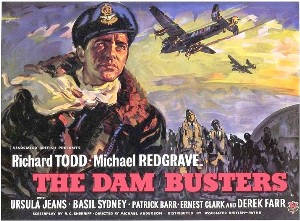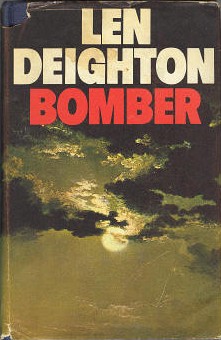
The Avro Lancaster is a British Second World War heavy bomber. It was designed and manufactured by Avro as a contemporary of the Handley Page Halifax, both bombers having been developed to the same specification, as well as the Short Stirling, all three aircraft being four-engined heavy bombers adopted by the Royal Air Force (RAF) during the same era.

The Dam Busters is a 1955 British epic war film starring Richard Todd and Michael Redgrave. It was directed by Michael Anderson. The film recreates the true story of Operation Chastise when in 1943 the RAF's 617 Squadron attacked the Möhne, Eder, and Sorpe dams in Nazi Germany with Barnes Wallis's bouncing bomb.

The Avro 679 Manchester was a British twin-engine heavy bomber developed and manufactured by the Avro aircraft company in the United Kingdom. While not being built in great numbers, it was the forerunner of the famed and vastly more successful four-engined Avro Lancaster, which was one of the most capable strategic bombers of the Second World War.

The Avro Type 694 Lincoln is a British four-engined heavy bomber, which first flew on 9 June 1944. Developed from the Avro Lancaster, the first Lincoln variants were initially known as the Lancaster IV and V; these were renamed Lincoln I and II. It was the last piston-engined bomber operated by the Royal Air Force (RAF).

The Handley Page Halifax is a British Royal Air Force (RAF) four-engined heavy bomber of the Second World War. It was developed by Handley Page to the same specification as the contemporary twin-engine Avro Manchester.
The Pathfinders were target-marking squadrons in RAF Bomber Command during World War II. They located and marked targets with flares, at which a main bomber force could aim, increasing the accuracy of their bombing. The Pathfinders were normally the first to receive new blind-bombing aids such as Gee, Oboe and the H2S radar.

No. 7 Squadron of the Royal Air Force operates the Boeing Chinook HC6 from RAF Odiham, Hampshire.

No. 8 Group RAF was a Royal Air Force group which existed during the final year of the First World War and during the Second World War.

Squadron Leader Ian Willoughby Bazalgette was a Canadian-British pilot in the Royal Air Force during the Second World War. On 4 August 1944, while piloting an Avro Lancaster in a pathfinder role, Bazalgette and crew flew to Trossy St. Maximin in France to mark a V-1 flying bomb storage cave. Bazalgette's Lancaster was severely damaged by flak prior to arrival at the target and quickly set on fire. Despite the condition of his aircraft, Bazalgette continued to the target and accurately dropped his markers. After completing the task, Bazalgette ordered his crew to bail out, however, two members of the crew were wounded and unable to jump. Rather than saving himself and leaving the two men to die, Bazalgette attempted to land the burning plane to save his two crew members. Bazalgette landed the plane, but it exploded almost immediately upon alighting, killing all three airmen. For his actions, Bazalgette was posthumously awarded the Victoria Cross.

Edwin (Ted) Essery Swales VC DFC was a South African pilot and Second World War hero. He was awarded the Distinguished Flying Cross and posthumously the Victoria Cross.

Bomber is a novel by Len Deighton that was published in the United Kingdom in 1970. It is the fictionalised account of "the events relating to the last flight of an RAF Bomber over Germany on the night of June 31st, 1943", a deliberately non-existent date, in which an RAF bombing raid on the Ruhr area of western Germany goes wrong. In each chapter, the plot is advanced by seeing the progress of the day through the eyes of protagonists on both sides of the conflict.
John De Lacy Wooldridge, was a Royal Air Force officer and bomber pilot, and a British film composer.

Operation Bellicose was an attack by Avro Lancaster bombers of the Royal Air Force on a German radar factory housed in the former Zeppelin Works at Friedrichshafen and the Italian naval base at La Spezia. It was the first shuttle bombing raid in the Second World War and the second use of a Master Bomber. In early June 1943, a Central Interpretation Unit photo interpreter identified a stack of ribbed baskets at the Zeppelin Works. After Winston Churchill viewed the photos at RAF Medmenham on 14 June, No. 5 Group RAF received the surprise orders on 16 June to attack Friedrichshafen during the next full moon.

No. 463 Squadron RAAF was a Royal Australian Air Force heavy bomber squadron during World War II. The squadron was formed in the United Kingdom in late 1943 from personnel and aircraft allocated from No. 467 Squadron RAAF. The squadron was equipped with Avro Lancaster bombers and flew its first raids on Germany immediately after being formed. Operating as part of RAF Bomber Command No. 463 Squadron conducted raids against cities, industrial facilities and military targets in Germany, France and Norway throughout 1944 and until the end of the war in May 1945. Following the war, the squadron evacuated Allied prisoners of war from Europe until it was disbanded in late 1945.

No. 467 Squadron RAAF was a Royal Australian Air Force bomber squadron, active over North West Europe during World War II. Formed in November 1942 as an Article XV Squadron in Britain, the squadron was notionally an Australian squadron under the command of the Royal Air Force, and consisted of a mixture of personnel from various Commonwealth nations. After becoming operational in early 1943, the squadron flew operations in Occupied Europe until the end of the war flying Avro Lancaster heavy bombers. It was scheduled to deploy to the Far East to take part in further operations against Japan, but the war ended before it could complete its training and the squadron was disbanded in September 1945.

Air Marshal Sir Harold Brownlow Morgan "Micky" Martin, was an Australian bomber pilot and senior commander in the Royal Air Force (RAF). He took part in Operation Chastise, the RAF's "Dambusters" raid in 1943, and was described by journalist Sir Max Hastings as "one of the three great bomber pilots of the war". He rose to become a senior officer in the RAF, commanding RAF Germany and later serving as Air Member for Personnel, a member of the Air Council, the RAF's controlling body.
No. 83 Squadron RAF was a Royal Flying Corps and Royal Air Force squadron active from 1917 until 1969. It was operative during both the First World War and the Second World War.

Royal Air Force Warboys or more simply RAF Warboys is a former Royal Air Force heavy bomber station, situated just outside the village of Warboys in Huntingdonshire, England.

No. 156 Squadron RAF was a Royal Air Force Squadron that was active as a bomber unit in World War II.

Squadron Leader Daniel Trevor Bulmer "Danny" Everett, DFC and 2 Bars, was a leading Royal Air Force Bomber Command and Pathfinder Force pilot and bombing leader, decorated three times for gallantry before being killed in action.

















